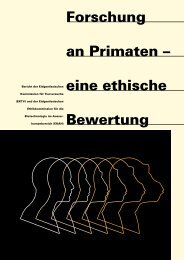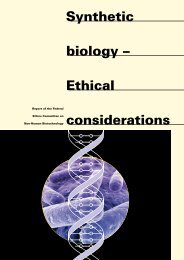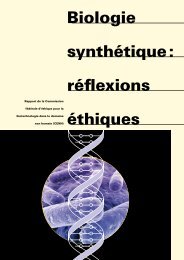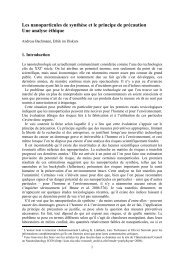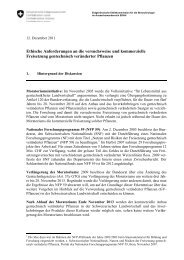Helmut Segner Fish Nociception and pain A biological perspective
Helmut Segner Fish Nociception and pain A ... - EKAH - admin.ch
Helmut Segner Fish Nociception and pain A ... - EKAH - admin.ch
- No tags were found...
Create successful ePaper yourself
Turn your PDF publications into a flip-book with our unique Google optimized e-Paper software.
hyperalgesia (Tracey 2005). Also, it is at the level of the brainstem<br />
where nociceptive information can be integrated with arousal or<br />
autonomic processes, thereby linking nociception with overall<br />
homeo static regulation in the organism.<br />
The large distributed network of interconnected cortical, subcortical<br />
<strong>and</strong> brainstem regions that is accessed during nociceptive<br />
processing is commonly referred to as <strong>pain</strong> circuit or “<strong>pain</strong> matrix”<br />
(Figures 3 <strong>and</strong> 4). The existence of this matrix highlights that <strong>pain</strong><br />
perception is not a matter of one specific brain region or brain part,<br />
but arises from a concerted network activity. Based on neuroanatomical,<br />
neurophysiological, pharmacological <strong>and</strong> neuroimaging<br />
data, the <strong>pain</strong> matrix is often subdivided into a lateral <strong>and</strong> medial<br />
<strong>pain</strong> systems, with both systems containing brainstem, subcortical<br />
as well as cortical components (Schnakers <strong>and</strong> Zasler 2007,<br />
Tracey <strong>and</strong> Mantyh 2007). The literature is not always consistent<br />
regarding what regions are to be included in the two systems, but<br />
generally the lateral <strong>pain</strong> system is considered to consist of the<br />
lateral thalamus, primary <strong>and</strong> secondary somatosensory cortex (SI<br />
<strong>and</strong> SII), parietal operculum <strong>and</strong> insula, while the medial system<br />
includes the medial thalamus, anterior cingulate cortex, prefrontal<br />
cortex, amygdala, hippocampus, hypothalamus, nucleus accumbens,<br />
<strong>and</strong> periaqueductal grey matter (i. e. mainly components of<br />
the “limbic system” that are known to be connected to affect). In<br />
addition, there exist connections of both systems to motor-related<br />
brain regions such as primary motor cortex, striatum <strong>and</strong> cerebellum,<br />
as they are also part of the <strong>pain</strong> matrix (Peyron et al. 2000).<br />
It has been proposed that the lateral <strong>and</strong> medial <strong>pain</strong> systems<br />
have distinctive roles in producing <strong>pain</strong> perception: Activation<br />
of the lateral <strong>pain</strong> system is thought to be related to the sensorydiscriminative<br />
aspects of <strong>pain</strong>, while the medial system is believed<br />
to participate primarily in the emotional-cognitive aspects (Peyron<br />
et al. 2000, Price 2000). Already at the thalamic level, a subdivision<br />
into a sensory <strong>and</strong> emotional-cognitive part appears to be<br />
realized, as specific thalamic nuclei are interconnected with the<br />
lateral system <strong>and</strong> other nuclei with the medial system (Millan<br />
1999, Perl 2007). Those thalamic nuclei which belong to the medial<br />
system are known to play a role in affective <strong>and</strong> motivational<br />
reactions, while those of the lateral system are involved in somatosensory<br />
functions.<br />
Pain Matrix<br />
cortex<br />
spinal cord<br />
nociceptors<br />
sensorydiscriminative<br />
thalamus, brain stem,<br />
subcortex<br />
affectivecognitive<br />
Figure 4: Sensory, affective <strong>and</strong><br />
cognitive processing of nociceptive<br />
input in the brain results in <strong>pain</strong><br />
sensation<br />
The – at least partly artificial – distinction is an attempt to discriminate<br />
between those elements of <strong>pain</strong> perception which respond<br />
primarily to stimulus intensity, from those parts which reflect primarily<br />
the emotional side (“unpleasantness”) of the <strong>pain</strong> sensation.<br />
Support for the concept of an at least partial division of <strong>pain</strong> sensation<br />
into perceptions of different quality comes from clinical observations<br />
which show that selective lesions on the anterior cingulate<br />
cortex alleviate the affective component of <strong>pain</strong>, while lesions to<br />
SI/SII cortical regions affect the discriminative component of <strong>pain</strong><br />
26 <strong>Fish</strong>. <strong>Nociception</strong> <strong>and</strong> <strong>pain</strong> | Contributions to Ethics <strong>and</strong> Biotechnology<br />
<strong>Fish</strong>. <strong>Nociception</strong> <strong>and</strong> <strong>pain</strong> | Contributions to Ethics <strong>and</strong> Biotechnology<br />
27



